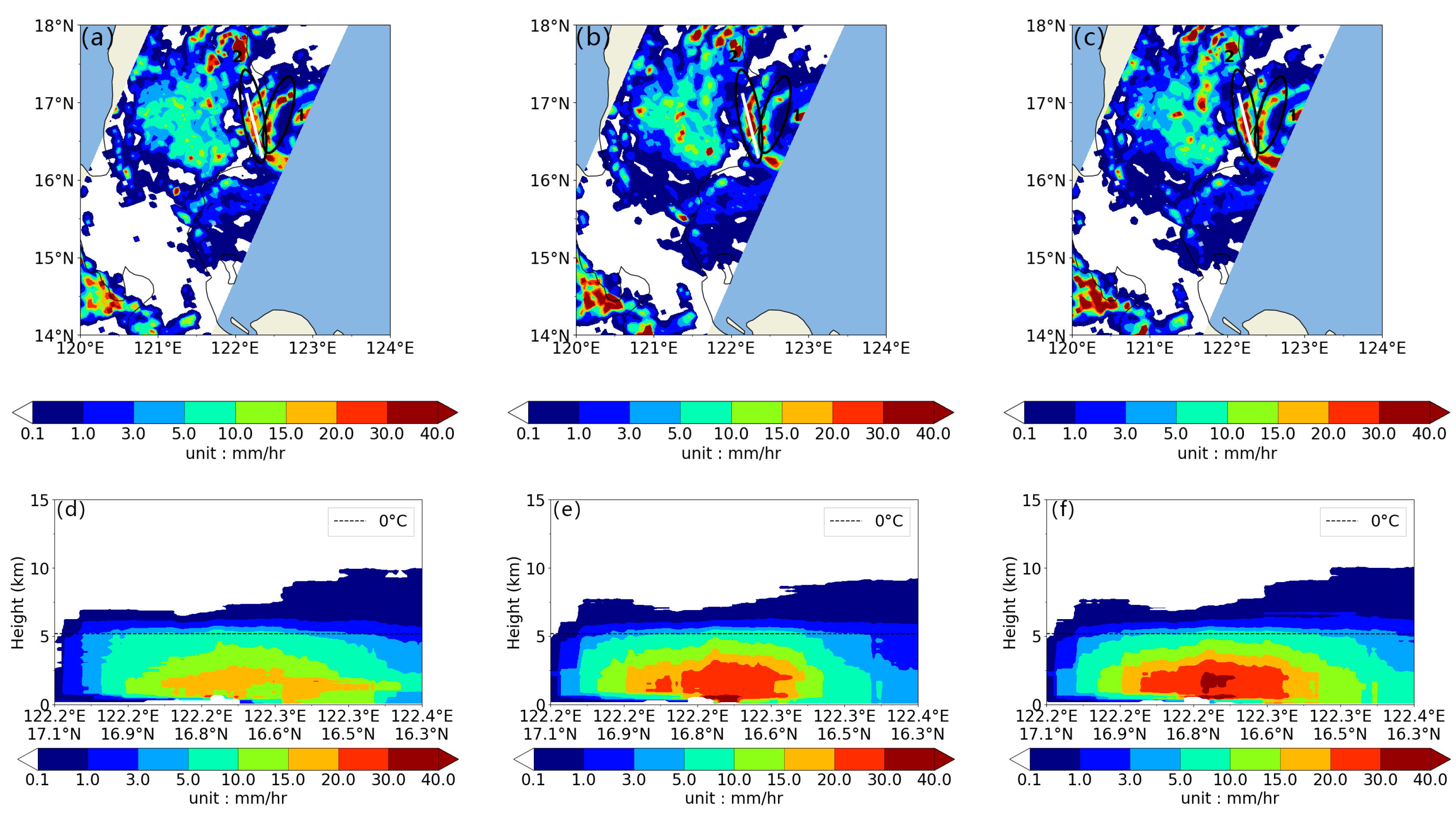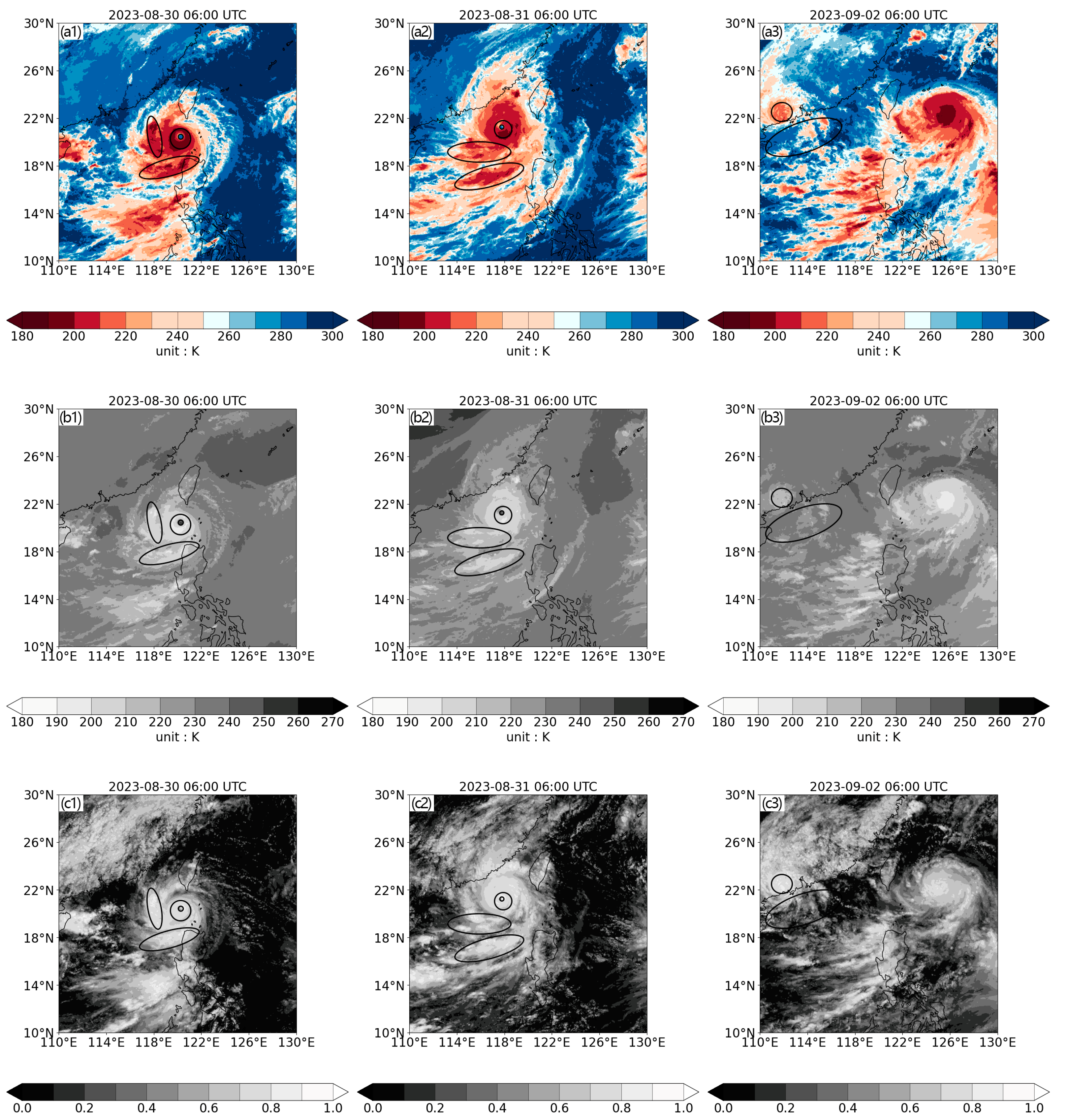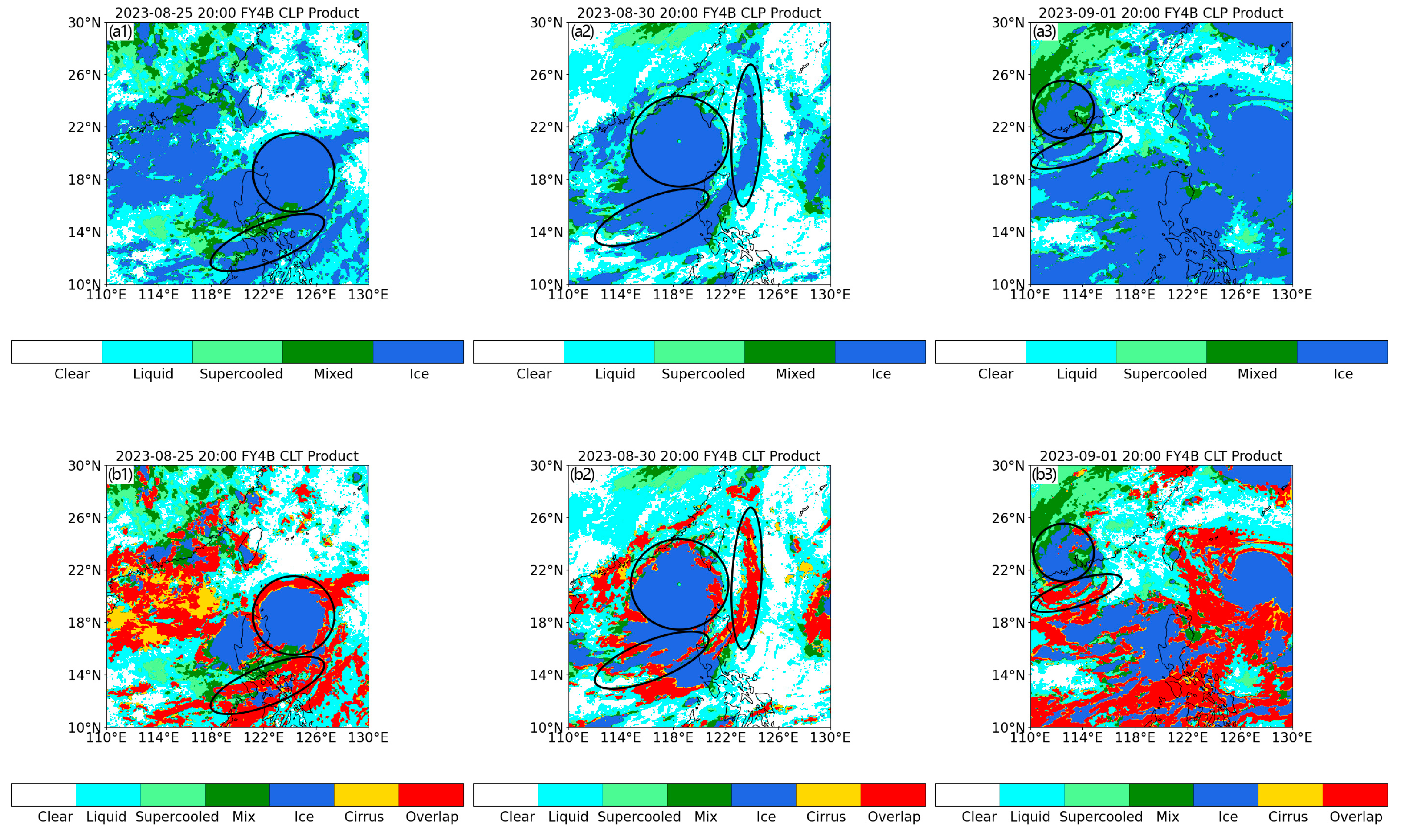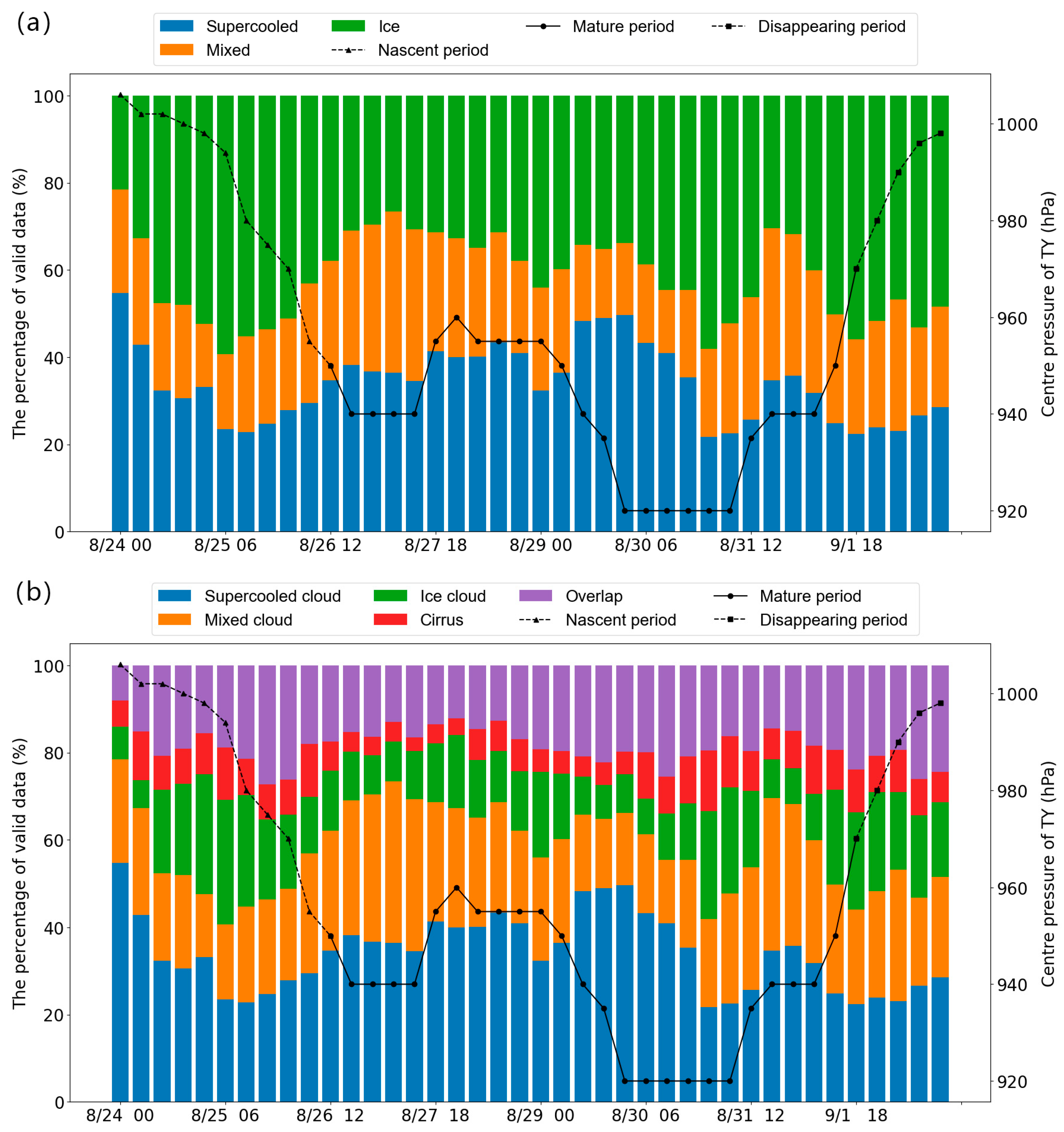Revisiting the Characteristics of Super Typhoon Saola (2023) Using GPM, Himawari-9 and FY-4B Satellite Data
Abstract
1. Introduction
2. Data and Methods
2.1. Overview of Typhoon Saola
2.2. GPM Satellite Data
2.3. Himawari-9 Satellite Data
2.4. FY-4B Satellite Data
2.5. Methods of Data Processing
- (1)
- GPM-1CGMI data require the valid brightness temperature of all channels to be between 160 K and 320 K. This is because, in the original datasets, the missing values were marked as −9999.9, which should be deleted. In addition, depending on the physical properties of the atmosphere and clouds, their brightness temperatures have inherent scopes, beyond or below which values are meaningless;
- (2)
- GPM-2ADPR data require the valid precipitation rate to be between 0 and 999 mm. Similar to GPM-1CGMI, the −9999.9 values in the original datasets were deleted. All the negative values were also deleted since 2ADPR products represent precipitation, which should not be lower than 0;
- (3)
- Himawari-9 data require the valid reflectivity of Channel03 (visible light band) to be between 0 and 1 and the valid brightness temperature of Channel08 (water vapor band) and Channel14 (long-wavelength infrared band) to be between 160 K and 320 K. For the Himawari-9 datasets, the −32,768 values (missing value), and values out of the reflectivity or brightness temperatures range (meaningless value) were deleted;
- (4)
- FY-4B CLP and CLT data exclude data with incorrect quality identification codes. In the original datasets, the variable named data quality flags (DQFs) is used to identify the data quality. For the CLP products, 0–4 represent five phases, and 5 represents “Uncertain” values—that is, the retrieval algorithm generating these products cannot determine the phase. For the CLT products, 0, 2–7 represent seven types, and 9 represents “Uncertain” values. In addition, 126 represents the unexplored space region of the satellite and 127 represents the missing value. All the 5, 9, 126, 127 values mentioned above were deleted before using the FY-4B datasets.
3. Results
3.1. Tracking Typhoon Features with GPM
3.1.1. Brightness Temperature
- In Channel03, the eye of the typhoon was shown as an area with a brightness temperature of around 240 K, but not clear. The brightness temperature of the eye wall was 260–280 K, indicating that the convective development was vigorous and the ice crystal layer was very thick. For the spiral cloud band area, the brightness temperature was 270–300 K, which corresponded to the thinner ice crystal layers (Figure 2a);
- In Channel09, the eye of the typhoon was clearer than that in Channel03, and the brightness temperature was over 280 K, while that of the eye wall was below 200 K, and the brightness temperature of the spiral cloud band area was 190–250 K (Figure 2b). Compared with the low-frequency Channel03, this channel could distinguish the radiation property differences in various cloud-top phases better, especially for the areas below 200 K in the typhoon eye wall and the spiral cloud band (Figure 2a,b). This is because these areas were highly correlated with the heavy precipitation, owing to the thick ice crystal layer and the attenuation effect of large raindrop particles;
- In Channel13, the brightness temperature of the typhoon eye was around 260 K, while that of the eye wall and spiral cloud band area was close to that of Channel09 (Figure 2c), indicating that the GMI’s ability to observe high brightness temperatures decreased with the increase in channel frequency. However, the GMI could adequately observe the developing vigorous convective area. The area below 200 K was larger and the shape was more complete on Channel13 compared with Channel09 (Figure 2b,c), indicating that the channel with the higher frequency had a better ability to observe thick ice cloud particles.
3.1.2. Precipitation Estimation
- In the mature period of Typhoon Saola, two distinct spiral cloud bands were formed. The 2AKa product clearly displayed the shape and location of these clouds and indicated that the near-surface rain intensity was 15–40 mm/h (Figure 3a). 2AKu did not detect the cloud band near the typhoon eye wall, but detected a cloud band that was far from the eye wall. Compared with 2Aka, the estimated near-surface rain intensity was larger, most of which was above 30 mm/h (Figure 3b). 2ADPR not only detected the two spiral cloud bands clearly but also estimated the near-surface rain intensity more accurately than 2Aka and 2Aku. As can be seen from Figure 3c, both the area and intensity of convective cells of the spiral cloud band near the eye wall were smaller than those of the others, indicating that the convective cloud development of the former was weaker;
- To analyze the precipitation rate at different heights in the vertical direction, the 2AKAa, 2Aku and 2ADPR products were profiled at the same position. The 2AKa product underestimated the storm heights (precipitation rate over 10 mm/h, hereafter the same), which were less than 5 km. The vertical precipitation estimation was also underestimated, with the maximum precipitation rate less than 20 mm/h (Figure 3d). The estimated storm heights of 2AKu were higher, reaching 5 km, and the 2AKu product distinguished the strong convective cloud with the maximum precipitation rate of more than 20 mm/h at around 3 km height (Figure 3e). Similar to 2AKu, the 2ADPR product also accurately distinguished storm heights and convective clouds in the vertical direction. However, compared with 2Aku, the other product also distinguished a height of about 0–2.5 km and a more intense precipitation region, with a precipitation rate of around 30–40 mm/h. Furthermore, the region was similar to the developing convective cloud (Figure 3f). These results illustrate that the product inversed by the DF algorithm has more advantages in identifying the vertical structure of typhoon clouds than the product inversed by the SF algorithm.
3.2. Tracking Typhoon Features with Himawari-9
- In the mature period of Typhoon Saola, the radius of the main body reached over 200 km. The typhoon eye was small and round, and the brightness temperature of the eye area was above 280 K. The eye wall area was clear and complete, represented as a 2° × 2° circular area, and the brightness temperature was 180–200 K. Most of the convective cloud was located on the southwest side of the typhoon center, with several convective cells whose brightness temperature was below 200 K (Figure 4(a1,a2)). These characteristics all indicate that Saola was a typical super typhoon. In the disappearing period, the typhoon eye disappeared, and the brightness temperature of both the eye wall and the outer region increased to 210–240 K (Figure 4(a3));
- Channel08 detects the water content in the upper layers of clouds. In the mature period of the typhoon, the brightness temperature distributions of Channel08 are similar to those of Channel14. The typhoon eye is represented as a dark area because sinking airflow cuts off the transportation of water vapor (Figure 4(b1,b2)). The brighter the eye wall and outer region of the cloud, the lower the indicated cloud-top brightness temperature and the stronger the convective development; this is because a large amount of water vapor was transported to the upper layers. In the disappearing period, convection in the cloud became weaker, and the water vapor transportation was relatively weakened; these areas on the cloud map also became darker (Figure 4(b3));
- At Channel03, the typhoon in the mature period had an obvious circulation center and a clear spiral structure. The strong convective activities were mostly located on the southwest side of the center, and the main body of the typhoon was asymmetric (Figure 4(c1,c2)). The brightness of the cloud on the map is also related to the convective development because the convective clouds that reached the tropopause mostly consisted of ice crystals with high reflectivity. In the disappearing period, the circulation center became unrecognizable, the spiral structures became looser and the convective areas became darker (Figure 4(c3)).
3.3. Tracking Typhoon Features with FY-4B
- In the nascent period of the typhoon, the percentage of the supercooled-phase pixels decreased rapidly from 50% to 20% and then increased to above 40% with the decrease in the typhoon’s central pressure. The mixed phase also displayed a tendency to decrease first and then increase, with an average percentage of about 20–30%. In contrast to the supercooled phase, the ice phase increased rapidly from 20% to 60% and then decreased to 30% (Figure 6a). The ice-phase cloud includes thick opaque ice, thin cirrus and multi-layer clouds. The percentages of these three types were between 5 and 30%, 5 and 10%, and 10 and 30%, and all their trends in this period were consistent with the ice-phase cloud (Figure 6b);
- In the mature period of the typhoon, the central pressure first increased and then decreased. Correspondingly, the percentage of supercooled-phase pixels first stabilized at between 40 and 50% and then rapidly decreased to 20%. The trend of the mixed phase was similar to that of the supercooled phase, accounting for only 15% at the strongest period of the typhoon (Figure 6a). The trends for all three types of ice-phase cloud were increase–decrease–increase, with percentages between 10 and 25%, 5 and 15%, and 15 and 30% (Figure 6b). In the disappearing period, the percentages of all the cloud phases and types changed similarly to in the nascent period, but with opposite increase and decrease trends;
- The period when the central pressure of Typhoon Saola reached its lowest (920 hPa) was taken for analysis. The results show that the percentages of various cloud types reached their extreme values at different times. Supercooled and mixed clouds decreased to their minimum levels of 21.7% at 00:00 on 31 August and 14.5% at 12:00 on 30 August, respectively. Ice cloud and cirrus both reached maximum levels of 24.8% and 13.7% at 00:00 on 31 August. Multi-layer cloud reached a maximum of 25.6% at 12:00 on 30 August.
4. Discussion
5. Conclusions and Implications
Author Contributions
Funding
Institutional Review Board Statement
Informed Consent Statement
Data Availability Statement
Conflicts of Interest
References
- Tropical Cyclone. (n.d.). Wikipedia.org. 2014. Available online: https://encyclopedia.thefreedictionary.com/Tropical+cyclone (accessed on 25 October 2023).
- Typhoon. (n.d.). Wikipedia.org. 2014. Available online: https://encyclopedia.thefreedictionary.com/typhoon (accessed on 25 October 2023).
- Emanuel, K. Increasing destructiveness of tropical cyclones over the past 30 years. Nature 2005, 436, 686–688. [Google Scholar] [CrossRef] [PubMed]
- Chien, F.-C.; Kuo, H.-C. On the extreme rainfall of Typhoon Morakot (2009). J. Geophys. Res. Atmos. 2011, 116, D05104. [Google Scholar] [CrossRef]
- Liu, D.; Pang, L.; Xie, B. Typhoon disaster in China: Prediction, prevention, and mitigation. Nat. Hazards 2009, 49, 421–436. [Google Scholar] [CrossRef]
- Yin, J.; Yin, Z.; Xu, S. Composite risk assessment of typhoon-induced disaster for China’s coastal area. Nat. Hazards 2013, 69, 1423–1434. [Google Scholar] [CrossRef]
- Zhao, Y.; Chen, Y.; Wu, C.; Li, G.; Ma, M.; Fan, L.; Zheng, H.; Song, L.; Tang, X. Exploring the contribution of environmental factors to evapotranspiration dynamics in the Three-River-Source region, China. J. Hydrol. 2023, 626, 130222. [Google Scholar] [CrossRef]
- Mas, E.; Bricker, J.; Kure, S.; Adriano, B.; Yi, C.; Suppasri, A.; Koshimura, S. Field survey report and satellite image interpretation of the 2013 Super Typhoon Haiyan in the Philippines. Nat. Hazards Earth Syst. Sci. 2015, 15, 805–816. [Google Scholar] [CrossRef]
- Chen, L.; Xu, Y. Review of typhoon very heavy rainfall in China. Meteorol. Environ. Sci. 2017, 40, 3–10. (In Chinese) [Google Scholar]
- Wang, H.P. Research on rainfall forest errors and their sources of typhoon influencing China in 2019. Meteorol. Mon. 2023, 49, 1299–1314. (In Chinese) [Google Scholar]
- Ren, F.; Yang, H. An overview of advances in typhoon rainfall and its forecasting researches in China during the past 70 years and future prospects. Torrential Rain Disasters 2019, 38, 526–540. (In Chinese) [Google Scholar]
- Chen, L.; Murata, A.M.; Duan, Y.; Duong, L.; Chau, Y.; Li, P.; Black, M.; Cheng, L. Observations and forecasts of rainfall distribution. Sixth Int. Workshop Trop. Cyclones Top. 0.3 2006, 36–42. [Google Scholar]
- Chen, L.S.; Li, Y.; Cheng, Z.Q. An overview of research and forecasting on rainfall associated with landfalling tropical cyclones. Adv. Atmos. Sci. 2010, 27, 967–976. (In Chinese) [Google Scholar] [CrossRef]
- Xu, X.D.; Lu, C.; Xu, H.X.; Chen, L. A possible mechanism responsible for exceptional rainfall over Taiwan from Typhoon Morako. Atmos. Sci. Lett. 2011, 12, 294–299. (In Chinese) [Google Scholar] [CrossRef]
- Pan, Y.; Liu, A.K.; He, S.; Yang, J.; He, M.-X. Comparison of typhoon locations over ocean surface observed by various satellite sensors. Remote Sens. 2013, 5, 3172–3189. [Google Scholar] [CrossRef]
- Chen, S.; Hong, Y.; Cao, Q.; Kirstetter, P.; Gourley, J.; Qi, Y.; Zhang, J.; Howard, K.; Hu, J.; Wang, J. Performance evaluation of radar and satellite rainfalls for Typhoon Morakot over Taiwan: Are remote-sensing products ready for gauge denial scenario of extreme events. J. Hydrol. 2013, 506, 4–13. [Google Scholar] [CrossRef]
- Pun, I.F.; Lin, I.I.; Ko, D.S. New generation of satellite-derived ocean thermal structure for the Western North Pacific typhoon intensity forecasting. Prog. Oceanogr. 2014, 121, 109–124. [Google Scholar] [CrossRef]
- Ma, X.; Wang, J.; Huang, H.; Wang, X.; Wang, Z.; Hu, B. Comprehensive Analysis of Typhoon Nangka Based on the Satellite Data from the GPM, CloudSat and Himawari-8. Atmosphere 2023, 14, 440. [Google Scholar] [CrossRef]
- Cosner, C. Precipitation Measurement Missions [EB/OL]. Available online: http://pmm.nasa.gov/GPM/ (accessed on 22 December 2023).
- Meiqi, L.; Ming, W. GPM Data Application in Analysis of Vertical Structure of Typhoon ‘Mujigae’ Precipitation. Remote Sens. Technol. Appl. 2017, 32, 904–912. (In Chinese) [Google Scholar]
- Cai, Z.; Zheng, Y.; Duan, J.; Zhu, H.; Wu, J. Evaluation and correction of GPM satellite precipitation products during Typhoon “In-Fa” affecting Zhejiang. Torrential Rain Disasters 2023, 42, 704–715. (In Chinese) [Google Scholar]
- Chen, T.; Dong, L.; Luo, L.; Yang, S. Convection structure and impact on severe precipitation during landing of Typhoon Lekima. Meteorol. Mon. 2021, 47, 1433–1443. (In Chinese) [Google Scholar]
- Qi, W.; Yong, B.; Gourley, J.J. Monitoring the super typhoon lekima by GPM-based near-real-time satellite precipitation estimates. J. Hydrol. 2021, 603, 126968. [Google Scholar] [CrossRef]
- Wu, Z.; Huang, Y.; Zhang, Y.; Zhang, L.; Lei, H.; Zheng, H. Precipitation characteristics of typhoon Lekima (2019) at landfall revealed by joint observations from GPM satellite and S-band radar. Atmos. Res. 2021, 260, 105714. [Google Scholar] [CrossRef]
- Yu, C.; Hu, D.; Di, Y.; Wang, Y. Performance evaluation of IMERG precipitation products during typhoon Lekima (2019). J. Hydrol. 2021, 597, 126307. [Google Scholar] [CrossRef]
- Deng, X.; Wu, Y. Analysis of horizontal precipitation structure of typhoon area based on GPM detection data. Prog. Geophys. 2022, 37, 1799–1806. [Google Scholar]
- Liang, J.; Chan, K.T. Rainfall asymmetries of the western North Pacific tropical cyclones as inferred from GPM. Int. J. Climatol. 2021, 41, 5465–5480. [Google Scholar] [CrossRef]
- Huang, H.; Chen, F. Precipitation microphysics of tropical cyclones over the western North Pacific based on GPM DPR observations: A preliminary analysis. J. Geophys. Res. Atmos. 2019, 124, 3124–3142. [Google Scholar] [CrossRef]
- Huang, X.; Wu, Z.; Xie, Y.; Zhang, Y.; Zhang, L.; Zheng, H.; Xiao, W. Precipitation microphysics of locally-originated typhoons in the South China Sea based on GPM satellite observations. Remote Sens. 2023, 15, 2657. [Google Scholar] [CrossRef]
- Fan, N.; Lin, X.; Guo, H. An analysis for the applicability of global precipitation measurement mission (GPM) IMERG precipitation data in typhoons. Atmosphere 2023, 14, 1224. [Google Scholar] [CrossRef]
- Zhu, M.; He, J.; Fang, M.; Yin, Q. Application of GPM data in analysis of precipitation structure of Typhoon Doksuri. J. Arid Meteorol. 2018, 36, 997. (In Chinese) [Google Scholar]
- Lee, Y.K.; Li, J.; Li, Z.; Schmit, T. Atmospheric temporal variations in the pre-landfall environment of typhoon Nangka (2015) observed by the Himawari-8 AHI. Asia-Pac. J. Atmos. Sci. 2017, 53, 431–443. [Google Scholar] [CrossRef]
- Lin, J.Y.; Ho, H.; Zheng, Z.W. Improved Understanding of Typhoon-Induced Immediate Chlorophyll-A Response Using Advanced Himawari Imager (AHI) Onboard Himawari-8. Remote Sens. 2022, 14, 6055. [Google Scholar] [CrossRef]
- Tan, J.; Yang, Q.; Hu, J.; Huang, Q.; Chen, S. Tropical cyclone intensity estimation using Himawari-8 satellite cloud products and deep learning. Remote Sens. 2022, 14, 812. [Google Scholar] [CrossRef]
- Lu, J.; Feng, T.; Li, J.; Cai, Z.; Xu, X.; Li, L.; Li, J. Impact of assimilating Himawari-8-derived layered precipitable water with varying cumulus and microphysics parameterization schemes on the simulation of Typhoon Hato. J. Geophys. Res. Atmos. 2019, 124, 3050–3071. [Google Scholar] [CrossRef]
- Honda, T.; Miyoshi, T.; Lien, G.Y.; Nishizawa, S.; Yoshida, R.; Adachi, S.A.; Terasaki, K.; Okamoto, K.; Tomita, H.; Bessho, K. Assimilating all-sky Himawari-8 satellite infrared radiances: A case of Typhoon Soudelor (2015). Mon. Weather Rev. 2018, 146, 213–229. [Google Scholar] [CrossRef]
- Honda, T.; Takino, S.; Miyoshi, T. Improving a precipitation forecast by assimilating all-sky Himawari-8 satellite radiances: A case of Typhoon Malakas (2016). SOLA 2019, 15, 7–11. [Google Scholar] [CrossRef]
- Li, C.; Zhuang, X.; Ma, C.; Guo, X. Development of a blended radar reflectivity method based on satellite and radar and its application to the observation of typhoon “In-fa”. Mar. Forecast. 2022, 39, 84–93. (In Chinese) [Google Scholar]
- Tsukada, T.; Horinouchi, T. Estimation of the tangential winds and asymmetric structures in typhoon inner core region using Himawari-8. Geophys. Res. Lett. 2020, 47, e2020GL087637. [Google Scholar] [CrossRef]
- Tsujino, S.; Horinouchi, T.; Tsukada, T.; Kuo, H.; Yamada, H.; Tsuboki, K. Inner-core wind field in a concentric eyewall replacement of Typhoon Trami (2018): A quantitative analysis based on the Himawari-8 satellite. J. Geophys. Res. Atmos. 2021, 126, e2020JD034434. [Google Scholar] [CrossRef]
- Han, Y.; Zou, X.; Weng, F. Cloud and precipitation features of Super Typhoon Neoguri revealed from dual oxygen absorption band sounding instruments on board FengYun-3C satellite. Geophys. Res. Lett. 2015, 42, 916–924. [Google Scholar] [CrossRef]
- Zhang, X.; Xu, D.; Liu, R.; Shen, F. Impacts of FY-4A AGRI radiance data assimilation on the forecast of the super typhoon “in-fa” (2021). Remote Sens. 2022, 14, 4718. [Google Scholar] [CrossRef]
- Shu, A.; Shen, F.; Jiang, L.; Zhang, T.; Xu, D. Assimilation of Clear-sky FY-4A AGRI radiances within the WRFDA system for the prediction of a landfalling Typhoon Hagupit (2020). Atmos. Res. 2023, 283, 106556. [Google Scholar] [CrossRef]
- Niu, Z.; Zou, X. Comparison Among All-Sky Simulations, FY-3E MWTS-3 and FY-4A AGRI Observations of the First Typhoon Malakas in 2022. Earth Space Sci. 2022, 9, e2022EA002498. [Google Scholar] [CrossRef]
- Xie, T.; Chen, J.; Yan, J. A New Objective Typhoon Location Algorithm Considering a Perturbation Factor Based on FY-4A Brightness Temperature Data. J. Atmos. Ocean. Technol. 2022, 39, 2023–2038. [Google Scholar] [CrossRef]
- Zhang, P.; Xu, Z.; Guan, M.; Xie, L.; Xian, D.; Liu, C. Progress of Fengyun Meteorological Satellites Since 2020. Chin. J. Space Sci. 2022, 42, 724–732. (In Chinese) [Google Scholar] [CrossRef]
- Wang, Y.; Sun, Y.; Chen, Y.; Wu, C.; Huang, C.; Li, C.; Tang, X. Non-linear correlations exist between solar-induced chlorophyll fluorescence and canopy photosynthesis in a subtropical evergreen forest in Southwest China. Ecol. Indic. 2023, 157, 111311. [Google Scholar] [CrossRef]
- Yang, W.; Chen, Y.; Bai, W.; Sun, X.; Zheng, H.; Qin, L. Evaluation of Temperature and Humidity Profiles Retrieved from Fengyun-4B and Implications for Typhoon Assimilation and Forecasting. Remote Sens. 2023, 15, 5339. [Google Scholar] [CrossRef]
- Wu, Z.; Zhang, Y.; Zhang, L.; Zheng, H. Interaction of cloud dynamics and microphysics during the rapid intensification of super-typhoon Nanmadol (2022) based on multi-satellite observations. Geophys. Res. Lett. 2023, 50, e2023GL104541. [Google Scholar] [CrossRef]
- Chan, P.; Choy, C.W.; Chiu, Y. Observational Study of Super Typhoon Saola in 2023 When It Was Close to Hong Kong. Preprints 2023, 09, 1688. [Google Scholar] [CrossRef]
- Chan, P.; He, Y.; Lui, Y. Super Typhoon Saola (2309) affecting Hong Kong in September 2023—Forecasting Aspect. Preprints 2023, 09, 1634. [Google Scholar] [CrossRef]
- Advanced Geostationary Radiation Imager. (n.d.). Available online: http://www.nsmc.org.cn/nsmc/en/instrument/AGRI.html (accessed on 22 December 2023).
- Li, B. FY-4B CLP Product Feature Card. 2023. Available online: https://img.nsmc.org.cn/PORTAL/NSMC/DATASERVICE/DataFormat/FY4B/Data/Format/FY-4B_AGRI_L2_CLP_4000M_V1.0.1.pdf (accessed on 7 February 2024).
- Li, B. FY-4B CLT Product Feature Card. 2023. Available online: https://img.nsmc.org.cn/PORTAL/NSMC/DATASERVICE/DataFormat/FY4B/Data/Format/FY-4B_AGRI_L2_CLT_4000M_V1.0.1.pdf (accessed on 7 February 2024).






| No. Channel | Central Frequency (GHz) | Band Width (MHz) | Spatial Resolution (km × km) |
|---|---|---|---|
| 01, 02 | 10.65 | 100 | 32.1 × 19.4 |
| 03, 04 | 18.7 | 200 | 18.1 × 10.9 |
| 05 | 23.8 | 400 | 16.0 × 9.7 |
| 06, 07 | 36.64 | 1000 | 15.6 × 9.4 |
| 08, 09 | 89 | 6000 | 7.2 × 4.4 |
| 10, 11 | 166 | 4000 | 6.3 × 4.1 |
| 12 | 183.31 ± 3 | 2000 | 5.8 × 3.8 |
| 13 | 183.31 ± 7 | 2000 | 5.8 × 3.8 |
| No. Channel | Central Wavelength (μm) | Spatial Resolution (km) |
|---|---|---|
| 01 | 0.47 | 1.0 |
| 02 | 0.51 | 1.0 |
| 03 | 0.64 | 0.5 |
| 04 | 0.86 | 1.0 |
| 05 | 1.6 | 2.0 |
| 06 | 2.3 | 2.0 |
| 07 | 3.9 | 2.0 |
| 08 | 6.2 | 2.0 |
| 09 | 6.9 | 2.0 |
| 10 | 7.3 | 2.0 |
| 11 | 8.6 | 2.0 |
| 12 | 9.6 | 2.0 |
| 13 | 10.4 | 2.0 |
| 14 | 11.2 | 2.0 |
| 15 | 12.3 | 2.0 |
| 16 | 13.3 | 2.0 |
Disclaimer/Publisher’s Note: The statements, opinions and data contained in all publications are solely those of the individual author(s) and contributor(s) and not of MDPI and/or the editor(s). MDPI and/or the editor(s) disclaim responsibility for any injury to people or property resulting from any ideas, methods, instructions or products referred to in the content. |
© 2024 by the authors. Licensee MDPI, Basel, Switzerland. This article is an open access article distributed under the terms and conditions of the Creative Commons Attribution (CC BY) license (https://creativecommons.org/licenses/by/4.0/).
Share and Cite
Wang, Y.; Xia, B.; Chen, Y.; Chen, H.; Xie, J. Revisiting the Characteristics of Super Typhoon Saola (2023) Using GPM, Himawari-9 and FY-4B Satellite Data. Atmosphere 2024, 15, 290. https://doi.org/10.3390/atmos15030290
Wang Y, Xia B, Chen Y, Chen H, Xie J. Revisiting the Characteristics of Super Typhoon Saola (2023) Using GPM, Himawari-9 and FY-4B Satellite Data. Atmosphere. 2024; 15(3):290. https://doi.org/10.3390/atmos15030290
Chicago/Turabian StyleWang, Yuanmou, Baicheng Xia, Yanan Chen, Huan Chen, and Jing Xie. 2024. "Revisiting the Characteristics of Super Typhoon Saola (2023) Using GPM, Himawari-9 and FY-4B Satellite Data" Atmosphere 15, no. 3: 290. https://doi.org/10.3390/atmos15030290
APA StyleWang, Y., Xia, B., Chen, Y., Chen, H., & Xie, J. (2024). Revisiting the Characteristics of Super Typhoon Saola (2023) Using GPM, Himawari-9 and FY-4B Satellite Data. Atmosphere, 15(3), 290. https://doi.org/10.3390/atmos15030290








